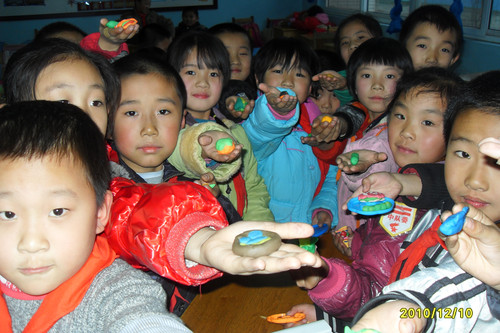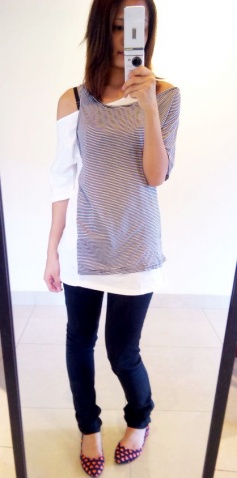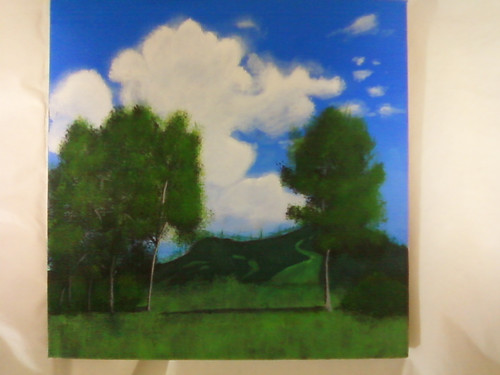the value of art cited from the internet...
luyued 发布于 2011-05-28 03:49 浏览 N 次part one: What is the value of art? It's something most artists think about at least once in their lives, and for many of us it is a nearly daily consideration.
In this article, I present my views on the value of art, and the how and why of those views. Value can be a very difficult thing to assess, because it is so tied up with our emotions, and everyone seems to have a different view of the subject. I hope to be able to answer some of those questions, and help provide other artists with a possible guideline for the value of their own art. I know not everyone will agree with me, and that's fine. The most important thing is to understand that art has value, no matter what value each person gives each piece of art.
Every piece of art is different, and the value is unique to that piece of art and the person who encounters it.
Money is an obvious value, but that raises the question of how much? Social value? Certainly, but to whom and why? Personal value? Of course, or we wouldn't be creating the art, would we? How can you measure that?
I believe that every artist creates art for personal reasons and personal value. Often that personal value is externalized as family or social enrichment, charity work, political statement, monetary gain, or any of a million other things, but if those external things were not personally important, we would not put our time, energy, creativity, heart, and soul into creating the things that we do.
How much personal value art has is something that each of us can only determine for ourselves.
I met an amazing artist years ago who would leave his works wherever he happened to be when he finished them. I picked one of them up once, and tried to hand it to him, telling him that he had forgotten it on the table. He just brushed it off and said he didn't care. He'd just draw something else tomorrow. For him, it was the creation that mattered, not the finished product. On the other side of the coin, I have met countless artists over the years who would find it very difficult to part with even a single piece of art, or who had heartfelt regret for ever letting one go. Most of us, I think, fall somewhere in between the two extremes, keeping those pieces most special to us, and allowing others to move to other homes as sales or gifts.
It can be an incredible confidence boost when another person likes your art enough, considers it valuable enough, to spend good money on it. It can be equally disheartening to put it out there for sale and not have anyone pay a dime. So how do you know if you are asking too much? How do you know if price is the problem?
The most important monetary value that can be assigned to a piece of art is the one the artist him or herself gives it.
You must think a piece of art is worth the money being asked, and never settle for less than you think the minimum value of the art is. Selling art for too little can result in feeling used and unappreciated, because the customer got a "bargain" on something that was worth far more to the artist, something that carries with it a part of the artist's life, passion, and love.
Don't cheat yourself by parting with art for too little money - especially originals.
It is a very difficult thing to put a monetary value to your own art, but I can share with you how I figured out my prices. I started last year with a focus on pet portraits, so I went out into the web and looked up as many web sites of professional pet portrait artists as I could. I then focused only on those artists who had a comparable style and skill level to my own, or were more skilled. I ignored all the stylized, modern art pet portrait artists because they are actually not my competition. They appeal to a completely different customer base, take a completely different skill, and a completely different time scale to complete each piece. I wrote down all the commission prices from the web pages, and noted whether I thought they were more, less, or just as skilled as myself. That gave me a good idea of what the market value of pet portraits in my skill level was.
I cannot recommend doing that sort of research here on dA. Successful, professional artists are the standard by which art should be priced, and such artists will almost always have a domain of their own where they keep this information. DA is an amazing melting pot of artists of all styles, skills, and ages, so it can be difficult to sort out the hobbyists, weekend commission artists, and serious professionals. Many of your favorite professional artists here probably have their own domains, so go there and see what they are asking for their works.
After I had a good idea of the market values, I sat down with a bunch of photos a friend provided me and kept track of how much time it took me to draw them. I took the average number of hours, multiplied it by $10 (the minimum wage I would need to be able to survive if I was doing portraits full time), and checked to see if it matched up to the market value. It was pretty darned close, meaning that I should be capable of competing, at market prices, and still potentially make enough money to be able to get by. Those prices are what I base my realistic, original art prices on. I have gotten faster over the last year, but I am not going to reduce my prices because I consider them well within the range of a reasonable wage. Plus, I have a bit of a cushion in case a piece takes longer than expected.
It frightens me how many artists on dA monetarily undervalue their art. If you look around, you will see no shortage of artists who are willing to work for $5-$30 for an original commission. A lot of people seem to think that no one will pay more than that, but the truth is that people can and do pay more than that every day. There are very few art styles fast enough to provide a living wage at that price, even if the volume of commissions is high enough to keep the artist busy all week. As a result, price-competitive artists are capable of undercutting their competition, selling their art based almost solely on an undervalued price as opposed to the quality and relevance of their work. I don't think this helps anyone.
Determining the value of a non-commission piece is much easier if the artist kept track of the time it took to finish. The minimum value should be a skilled labor wage, at least $10/hour, but ideally closer to $15/hour. All art is skilled craftsmanship, and its value should reflect that. That means if I finish an original in 10 hours, and I want to sell it, I need to ask at least $100 for it. If I am selling it through a service or business that takes a commission, I need to add that amount to my sale price. For example, if an auction site charges a 10% commission, then I receive 90% of the sale price. That 90% must equal my $100 value.
Formula:
$min_value x 100 / %received = $min_sale_price
Example:
$100 x 100 / 90 = $111.11
Most galleries in my area take a 40% cut. That means, if I sold the same piece in a local gallery, 60% of the sale price would go to me.
Example:
$100 x 100 / 60 = $166.66
"High" prices are almost never the cause of slow sales. 99% of art sales is marketing. I'm still learning marketing myself, and it's very tough. There are so many amazing artists, that if you can't successfully market your art, you won't make many sales. That is also why less skilled artists sometimes make a very good livings. They know how and where to market their art.
If you still aren't sure about the value of your art, look at the hour-based price for your work and pretend you have enough disposable income that you could buy any piece of art you wanted. Would you think that piece of art was worth that much, or would you keep looking even though the money wouldn't be a hardship? If you'd keep moving, don't sell it, just keep doing your art and having fun.
I am very particular about the value of my own art, both personally and monetarily. I will never sell a piece for less than I believe it to be worth, but I will sometimes give it away. I once had a friend tell me that every friend of hers should have at least one print of hers in their home, and gave me one that I had been eying. I would have paid her the asking price, but to her it was of more value as a gesture of friendship. I would never dream of refusing such a gift.
Art can be an amazing gift, and when the person you are giving it to knows how much it means to you, that makes it even more special. I don't mean bragging on your prices, or telling the person receiving the piece what dollar value you would have asked of a stranger. I mean just a general knowledge that your art means something to you, has value, and conveys so much more than something bought at a store.
Our art is a part of us.
It contains our hours, months, years, or decades of accumulated skills and experiences.
It is the manifestation of our creativity.
It is the embodiment of our desires, hopes, and dreams.
It is the culmination of moments, hours, days, of time in our lives.
Yes, even if you are bored with your art, even if you feel uninspired, frustrated, or unimpressed, it is still all of these things and so much more.
That is the value of art. part two The Value of Art
By Shawn Olson
Posted on January 31st, 2005 After a distinctly self-contemplative night, I began to wonder what it is that attracts people to art. Certainly I consider myself an artist of sorts but what is it that makes me an artist? Why do I practice art? Why does anyone immerse themselves in abstract activities that, for the most part, do not add to financial security or other measurable values?
We know that art has been around before written language. Ancient carvings and cave-wall paintings attest to an early drive to participate in artistic endeavors. I would say that our skills as artists have improved since the first cave paintings but I think there must be the same seed of creativity that connects long forgotten ancestors and modern artists. I think that the most obvious similarity is that dedicated artists tend to create art that reflects important aspects of their lives. When it comes to ancient man, what could have been more important than food and reproduction? Ancient art is ripe with images of hunting and pregnant women.
As human society evolved into more stable communities, the art changed. Over time the focus on survival was supplanted with self-emulation. In ancient Egypt, for example, the art turned to worshipping the value of great kings and all-powerful gods. The same happened in most cultures.
I doubt that common slaves of Egypt felt that preserving kingly honor for eternity was a motivating factor; slaves probably would have produced an entirely different art than what we find in tombs had they the resources to create art. What is telling is that the art that survived from ancient times reflects directly the values of the people producing and preserving it: in terms of Egypt it was of the Pharaohs.
European Medieval art reflects a mixture of pagan and Christian ideals. We can deduce that local kings whose roots were largely pagan mixed with the influence of Rome. The artistic work commissioned throughout this time is a constant reminder of those influences.
Take this on up to our own time. An important note to take is that as the traditional religious values of historic importance in the west have been challenged in intellectual circles, the focus of art has strayed. Prehistoric art was focused on life and death ancient art turned to the afterlife and mysticism; modern art has no focus. I am confident that mass media and the internet have a large role in the change perhaps we are still too early in the new era to be able to define the motivating factor behind the art that will last; but I feel that the reality is that art has no focus in our age because it is not the secluded craft of the gifted and appointed.
Can we assume that we are different than ancient artists? I doubt we are different. The likely disparity is that very few humans, throughout the last ten thousand years, could afford to practice any artistic endeavors-those who weren't lucky enough to be drafted into the artist class had no time or money to be creative when they were in from the field. Modern humans have much more luxury than ancient people meaning they have the freedom to participate in artistic endeavors even if their art brings in little or no financial compensation.
So what is the value of art? Honestly, I really don't think that art has an enduring value. A piece of art is divine to one man and ridiculous to the next. Revered artists of the past may not have produced anything more amazing than countless others, but through happenstance become icons.
I feel that art is important, but its value is intangible. The more remote the art, the higher its value to our intellectual heritage but still it was simply created by simple men portraying their own simple values-or the values of their masters and employers. As a benchmark of our progress and set of values, art is important. But I turn my back on the high-brow notion that artists have a deeper insight on this world from the rest of humanity.
Art comes from our apparently innate desire to express ourselves; some of us, at least, feel the urge to be creative. I would wager that some of the art dug up from times past has less cultural significance than some archeologists say; there is a percentage of art created by any artist that has no deep inspiration beyond a desire to make something beautiful, novel or strange. Other art is simply a form of mimicking.
What is the objective value of a piece of art? I don't know and I doubt you know either. All I know is that art is an important part of our lives and I'm happy that I enjoy it. Moreover, I am glad I appreciate the act of conjuring artistic creations. There is no broad value to any specific piece of artwork in this world, in my opinion all art has local and temporal value-though some are fortunate to outlive others. But pieces that evoke wonder and appreciation and awe are definitely of utmost emotional value to anyone with an open mind or heart.
- 06-23· 2010年雅风书法之星
- 06-23· 荷塘月色雅风居 样板房
- 06-23· 我和雅风
- 06-23· 吉林市雅风诗社十七届诗
- 06-13· 淘宝北京购买新娘披肩披
- 06-13· (转载)说瑞丽
- 06-13· 襄樊新娘跟妆报价-先锋时
- 06-13· 《瑞丽》《时尚新娘》白
- 06-13· "淘宝网冬季婚纱礼服"淘宝
- 06-13· 新娘跟妆 2010.1.23“瑞丽日
- 06-06· 防治三高与“甘诺宝力B
- 06-02· “平安的圣诞”
- 06-01· 2010 FIFA (十) 如何干掉龟派
- 06-01· 诗歌的特点、分类、派流
- 06-01· 大始祖新恩公子孙派序
- 05-31· 花开有声 启智无形
- 05-31· 【转】 让花开有声
- 05-31· 梦里梦外:花开有声
- 05-31· [转载]陕西首届文化创意产
- 05-31· 创意学期末作业——创业










